| In vitro: |
| Biomed Res Int. 2013;2013:757126. | | Hepatoprotective and antioxidant effects of saponarin, isolated from Gypsophila trichotoma Wend. on paracetamol-induced liver damage in rats.[Pubmed: 23878818] | The hepatoprotective potential of Saponarin, isolated from Gypsophila trichotoma, was evaluated in vitro/in vivo using a hepatotoxicity model of paracetamol-induced liver injury.
METHODS AND RESULTS:
In freshly isolated rat hepatocytes, paracetamol (100 μ mol) led to a significant decrease in cell viability, increased LDH leakage, decreased levels of cellular GSH, and elevated MDA quantity. Saponarin (60-0.006 μ g/mL) preincubation, however, significantly ameliorated paracetamol-induced hepatotoxicity in a concentration-dependent manner. The beneficial effect of Saponarin was also observed in vivo. Rats were challenged with paracetamol alone (600 mg/kg, i.p.) and after 7-day pretreatment with Saponarin (80 mg/kg, oral gavage). Paracetamol toxicity was evidenced by increase in MDA quantity and decrease in cell GSH levels and antioxidant defence system. No changes in phase I enzyme activities of AH and EMND and cytochrome P 450 quantity were detected. Saponarin pretreatment resulted in significant increase in cell antioxidant defence system and GSH levels and decrease in lipid peroxidation. The biochemical changes are in good correlation with the histopathological data.
Protective activity of Saponarin was similar to the activity of positive control silymarin.
CONCLUSIONS:
On the basis of these results, it can be concluded that Saponarin exerts antioxidant and hepatoprotective activity against paracetamol liver injury in vitro/in vivo. |
|
| In vivo: |
| Phytomedicine. 2014 Jan 15;21(2):148-54. | | Protective effects of the apigenin-O/C-diglucoside saponarin from Gypsophila trichotoma on carbone tetrachloride-induced hepatotoxicity in vitro/in vivo in rats.[Pubmed: 24011529 ] | This study investigated the hepatoprotective activity of Saponarin, isolated from Gypsophila trichotoma Wend., using in vitro/in vivo hepatotoxicity model based on carbone tetrachloride (CCl₄)-induced liver damage in male Wistar rats.
METHODS AND RESULTS:
The effect of Saponarin was compared with those of silymarin. In vitro experiments were carried out in primary isolated rat hepatocytes. Cell incubation with CCl₄ (86 μmol l⁻¹) led to a significant decrease in cell viability, increased LDH leakage, decreased levels of cellular GSH and elevation in MDA quantity. Cell pre-incubation with Saponarin (60-0.006 μg/ml) significantly ameliorated CCl₄-induced hepatic damage in a concentration-dependent manner. These results were supported by the following in vivo study. Along with decreased MDA quantity and increased level of cell protector GSH, seven day pre-treatment of rats with Saponarin (80 mg/kg bw; p.o.) also prevented CCl₄ (10%, p.o.)-caused oxidative damage by increasing antioxidant enzyme activities (CAT, SOD, GST, GPx, GR). Biotransformation phase I enzymes were also assessed. Administered alone, Saponarin decreased EMND and AH activities but not at the same extent as CCl₄ did. However, pre-treatment with Saponarin significantly increased enzyme activities in comparison to CCl₄ only group. The observed biochemical changes were consistent with histopathological observations where the hepatoprotective effect of Saponarin was comparative to the effects of the known hepatoprotecor silymarin.
CONCLUSIONS:
Our results suggest that Saponarin, isolated from Gypsophila trichotoma Wend., showed in vitro and in vivo hepatoprotective and antioxidant activity against CCl₄-induced liver damage. | | J Enzyme Inhib Med Chem. 2009 Jun;24(3):684-90. | | Hypoglycemic activity of the antioxidant saponarin, characterized as alpha-glucosidase inhibitor present in Tinospora cordifolia.[Pubmed: 18951283] |
METHODS AND RESULTS:
Tinospora cordifolia, used in anti-diabetic herbal drug preparations, was reported [12] to contain an alpha-glucosidase inhibitor, characterized as Saponarin (apigenin-6-C-glucosyl-7-O-glucoside).
The leaf extract had appreciable antioxidant and hydroxyl radical scavenging activities and contained the flavonoid in the range of 32.1 /- 1.5-45.5 /- 3.5 mg/g of dry solid. Saponarin showed mixed competitive inhibition on activities of alpha-glucosidase and sucrase of different origins. IC(50), Ki and ki' values determined were 48 muM, 8 muM and 19.5 microM respectively for intestinal maltase and 35 microM, 6 microM and 13 microM respectively for intestinal sucrase.
CONCLUSIONS:
When given orally to maltose-fed rat, Saponarin showed hypoglycemic activity in the range of 20-80 mg/kg compared to 100-200 mg/kg for acarbose as reported. | | Phytomedicine. 2016 May 15;23(5):483-90. | | Antidiabetic and antioxidant effects of saponarin from Gypsophila trichotoma on streptozotocin-induced diabetic normotensive and hypertensive rats.[Pubmed: 27064007 ] | Diabetes and hypertension are diseases that often coexist, which increases the risk of chronic organ damages and cardiovascular complications. To evaluate the effects of Saponarin, isolated from Gypsophila trichotoma Wend, on blood pressure, glycemia, body weight, and liver biochemical parameters related to oxidative stress in diabetic normotensive Wistar Kyoto rats (NTR) and spontaneously hypertensive rats (SHR).
METHODS AND RESULTS:
Diabetes was induced by administration of streptozotocin (40 mg/kg, i.p.). The following biochemical parameters: reduced glutathione (GSH), malondialdehyde (MDA), total cytochrome P450, aniline hydroxylase (AH) activity, as well as the activities of antioxidant enzymes such as glutathione peroxidase (GPx), glutathione reductase (GR) and glutathione S-transferase (GST) were measured in the livers of euthanized rats. Saponarin exerted slight antihypertensive activity in non-diabetic SHR, judged by 19% (p<0.05) decrease of the initial blood pressure. However, such effect was not observed in streptozotocin-induced diabetic SHR (SHR-D). Streptozotocin-induced diabetes was evidenced by 78% (p<0.05) and by 171% (p<0.05) increase in blood glucose level in NTR and SHR, respectively. In non-diabetic SHR the initial MDA quantity was by 36% (p<0.05) higher and the initial GSH levels were by 28% (p<0.05) lower in comparison to non-diabetic NTR. Significant decrease in the activities of GPx, GR, and GST was measured in the livers of all diabetic rats. Treatment with Saponarin ameliorated the above mentioned liver parameters in both diabetic strains, however its effects were less pronounced in the diabetic SHR group.
CONCLUSIONS:
Taken together our data indicate that diabetes and hypertension in combination are more difficult to be modulated by Saponarin. | | J Enzyme Inhib Med Chem. 2009 Jun;24(3):684-90. | | Hypoglycemic activity of the antioxidant saponarin, characterized as alpha-glucosidase inhibitor present in Tinospora cordifolia.[Pubmed: 18951283 ] | Tinospora cordifolia, used in anti-diabetic herbal drug preparations, was reported [12] to contain an alpha-glucosidase inhibitor, characterized as Saponarin (apigenin-6-C-glucosyl-7-O-glucoside).
METHODS AND RESULTS:
The leaf extract had appreciable antioxidant and hydroxyl radical scavenging activities and contained the flavonoid in the range of 32.1 +/- 1.5-45.5 +/- 3.5 mg/g of dry solid. Saponarin showed mixed competitive inhibition on activities of alpha-glucosidase and sucrase of different origins. IC(50), Ki and ki' values determined were 48 muM, 8 muM and 19.5 microM respectively for intestinal maltase and 35 microM, 6 microM and 13 microM respectively for intestinal sucrase.
CONCLUSIONS:
When given orally to maltose-fed rat, Saponarin showed hypoglycemic activity in the range of 20-80 mg/kg compared to 100-200 mg/kg for acarbose as reported. |
|


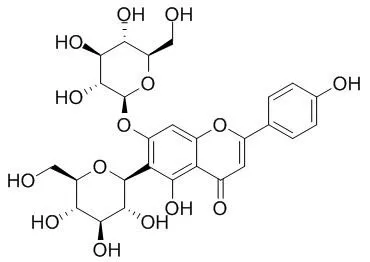

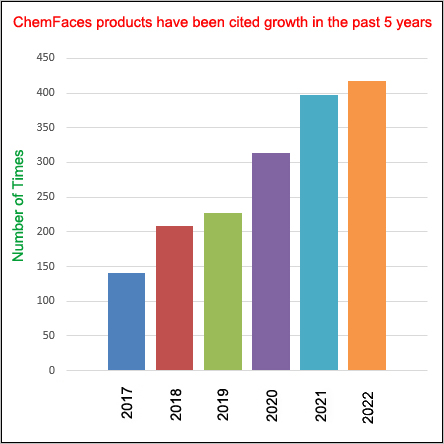
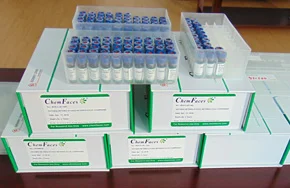
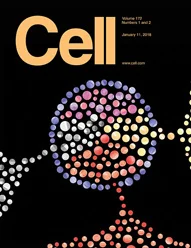 Cell. 2018 Jan 11;172(1-2):249-261.e12. doi: 10.1016/j.cell.2017.12.019.IF=36.216(2019)
Cell. 2018 Jan 11;172(1-2):249-261.e12. doi: 10.1016/j.cell.2017.12.019.IF=36.216(2019)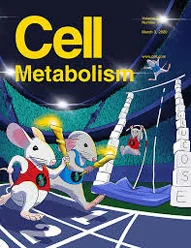 Cell Metab. 2020 Mar 3;31(3):534-548.e5. doi: 10.1016/j.cmet.2020.01.002.IF=22.415(2019)
Cell Metab. 2020 Mar 3;31(3):534-548.e5. doi: 10.1016/j.cmet.2020.01.002.IF=22.415(2019)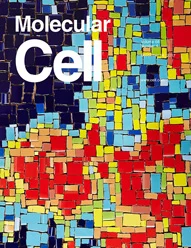 Mol Cell. 2017 Nov 16;68(4):673-685.e6. doi: 10.1016/j.molcel.2017.10.022.IF=14.548(2019)
Mol Cell. 2017 Nov 16;68(4):673-685.e6. doi: 10.1016/j.molcel.2017.10.022.IF=14.548(2019)